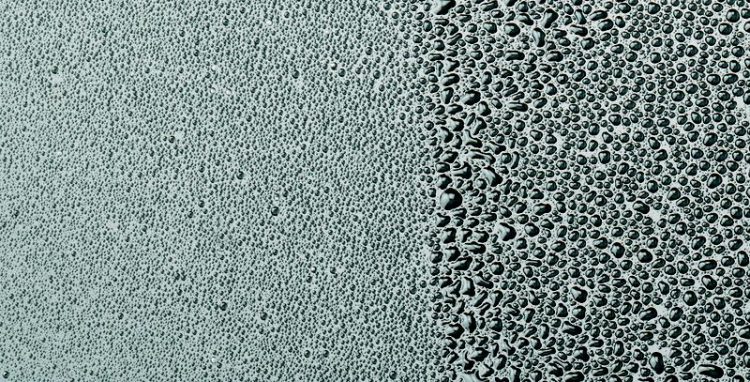Technology transfer: Automated quality assurance of CFRP surfaces becomes industrial reality

Change in droplet size at the boundary between a flame-treated (right) and non flame-treated (left) polypropylene blend. (c) Fraunhofer IFAM
Lightweight aircraft and cars are designed using components made of carbon fiber reinforced plastic (CFRP).
The manufacture of these CFRP components is carried out in metallic molds. Demolding is generally facilitated by treating the molds beforehand with a release agent.
However, some release agent adheres to the molded product and these residues must be removed manually prior to subsequent coating or bonding.
Contamination of CFRP surfaces by release agent residues impairs adhesion and hence the quality of bonded joints. So how can such residues be detected on components?
Automated monitoring of CFRP surfaces
Fraunhofer IFAM scientists have developed an automated aerosol wetting test suitable for industrial production. This wetting test efficiently inspects the surfaces of large components during the production process.
An ultrasonic atomizer first of all generates a defined water aerosol. This then creates a characteristic pattern of droplets on the component surface that is being inspected. A camera system records these droplets and shows them on a screen.
The droplet size distribution allows statements to be made about the wetting properties of the surface. By defining target values, for example, the cleaning and activation effect of a surface pretreatment step can be automatically monitored.
The advantage of the aerosol test is that large surfaces, for example fiber composite components for aircraft and wind turbines, can also be tested. The water aerosol dries within a very short time and leaves no residues, meaning the components can be further processed shortly after inspection.
Media Contact
All latest news from the category: Materials Sciences
Materials management deals with the research, development, manufacturing and processing of raw and industrial materials. Key aspects here are biological and medical issues, which play an increasingly important role in this field.
innovations-report offers in-depth articles related to the development and application of materials and the structure and properties of new materials.
Newest articles

First-of-its-kind study uses remote sensing to monitor plastic debris in rivers and lakes
Remote sensing creates a cost-effective solution to monitoring plastic pollution. A first-of-its-kind study from researchers at the University of Minnesota Twin Cities shows how remote sensing can help monitor and…

Laser-based artificial neuron mimics nerve cell functions at lightning speed
With a processing speed a billion times faster than nature, chip-based laser neuron could help advance AI tasks such as pattern recognition and sequence prediction. Researchers have developed a laser-based…

Optimising the processing of plastic waste
Just one look in the yellow bin reveals a colourful jumble of different types of plastic. However, the purer and more uniform plastic waste is, the easier it is to…



